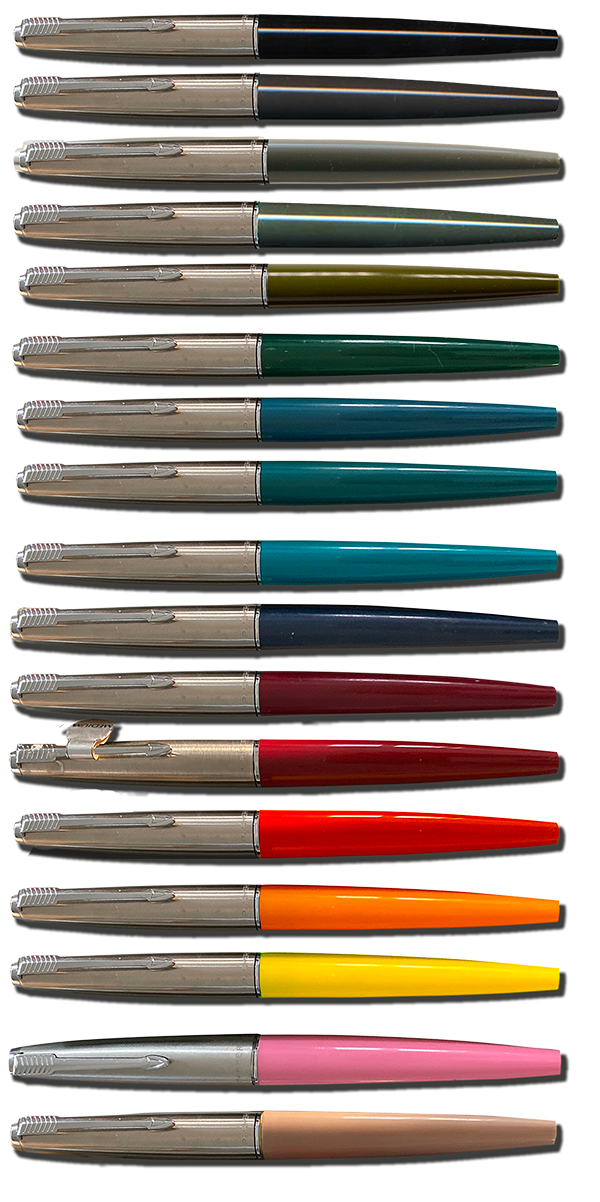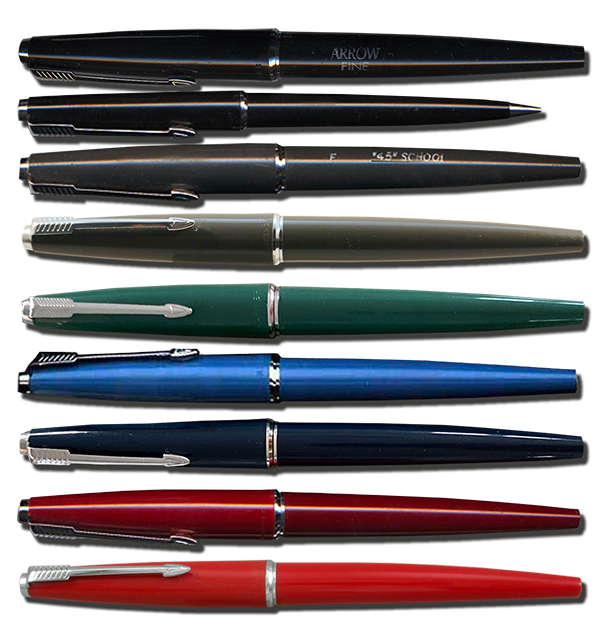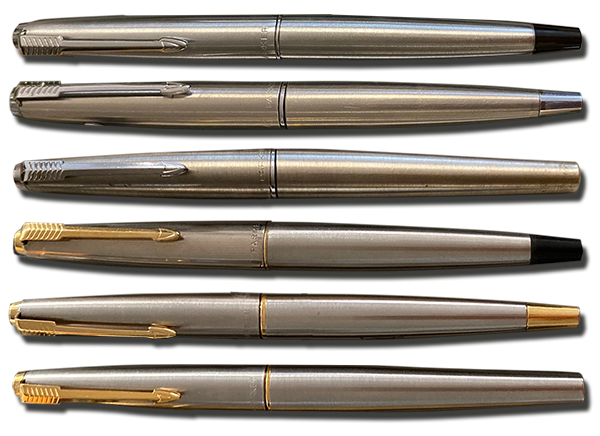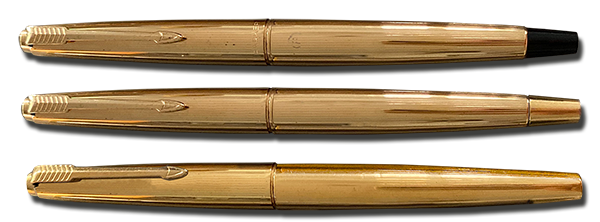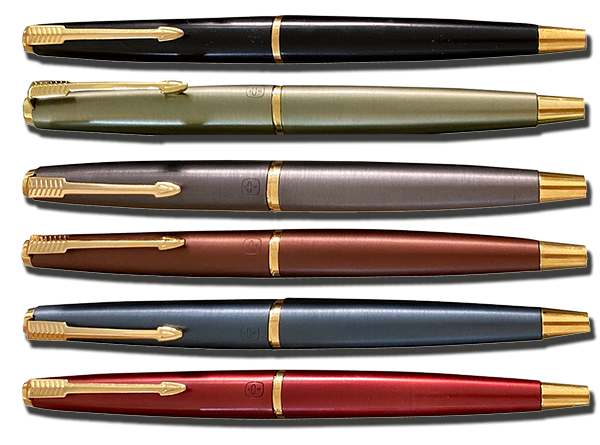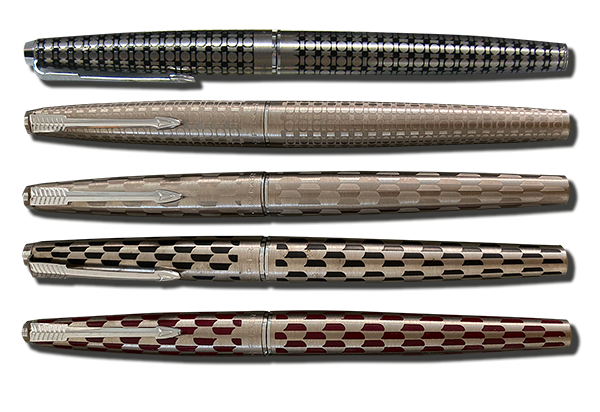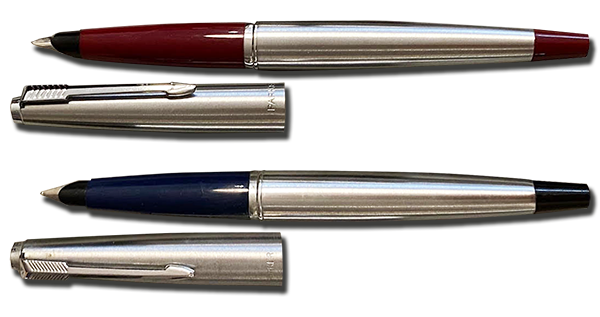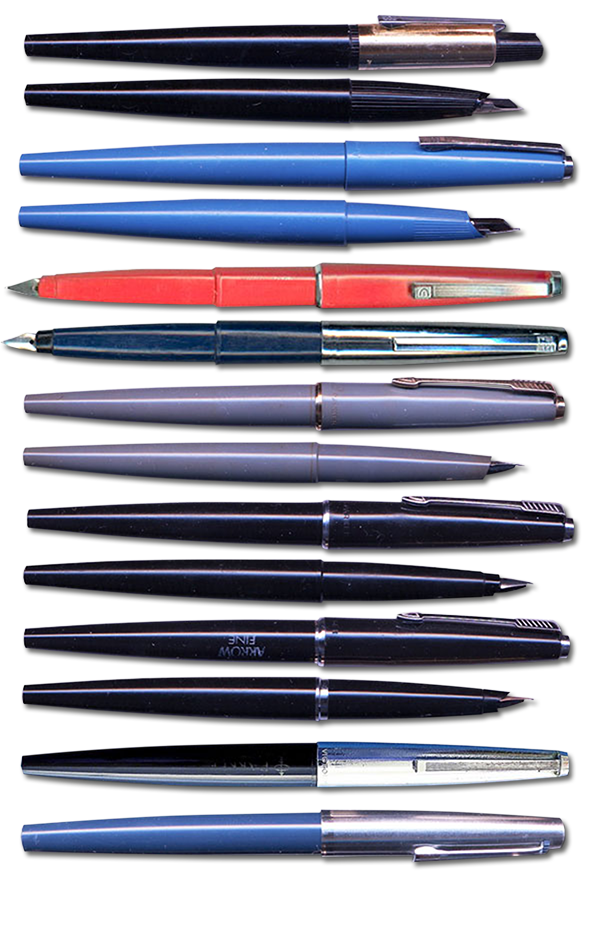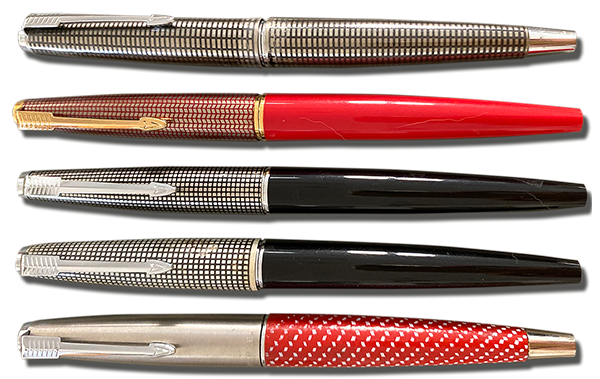
| parkerpens.net |
| PARKERCOLLECTOR.COM |
|
Parkercollector.com — Online for 24 years! Click to read:
|
1960 — 2007 |
|
The main difference to the top lines being the material rather than the design. Thus the economy pens are more prone to breakage and often sported alloy, rather than gold, nibs. The threesome was the Parker 51 Special, virtually identical to the Parker 51 save the gold nib, the Parker 21, which, adding a few colours, also closely followed the design of the Parker 51, with the exception of an assortment of clip designs and, again, the lack of the gold nib. The third pen was the Parker 41 which was very similar to the Parker 21 but was offered in a range of clear "youthful" colours, today much sought for by collectors. |
|
Parker 45 Classic and Arrow Demonstrator, ca 1966. Image © courtesy of Tsachi Mitsenmacher
|
|
The Parker 45 was designed by Don Doman (who also designed the Jotter, Parker 61, Parker VP, Parker 75, Parker T1 and Liquid Lead). He based it on an Eversharp design, called the Eversharp "10 000", a cartridge pen the rights to which Parker aquired when they bought the pen division of Eversharp in 1957 (read more in the Parker "19" chapter). Not wanting to differ too much from their prize-winning design of the milk cow Parker 51, Doman initially kept the metal cap and the arrow clip but adopted the stylized clip of the Parker 21 Super, introduced in 1956. |
|
The many colours of the Parker 45 Classic Image © Tsachi Mitsenmacher, Susan Wirth, et al.
|
|
The Parker Classic colour range:
|
|
A cheaper Parker made sister pen to the Parker "45" was also offered under the Eversharp brand name, the Eversharp Challenger, introduced in 1962. It was virtually identical to the metal capped Parker "45" but didn't have the arrow clip. Instead it was fitted with a plain ridged clip very similiar to the rigded clips on the Parker "21" but with the Eversharp "E" on the top. It also lacked the metal body ring of the Parker "45". Although it did have the black ring close to the nib, missing on the siblings Big E and Parker "19".
The filler was tried on the new Parker 45 in 1960 and suddenly it was a smash hit. The novel filling system became very much in demand and was soon applied to other Parker models, such as late models of the Parker 61, the Parker 75 (1964-1994) and many other subsequent models. With the Parker VP (1962-64) Parker tried a different approach with a removable filler in plastic and metal, but this construction proved brittle and the Parker VP was soon discontinued. The cartridge/converter idea was also soon adopted by most other pen companies. Both the cartridge and converter became a manufacturers standard and is still being used today. |
|
A collection of Parker "45" Arrows Image © courtesy Tsachi Mitsenmacher, et al.
|
|
Since the Parker 45 sold surprisingly well Parker realised that the pen might have more potential than just as a cheap school pen. Thus Parker in 1964 launched a top line Parker 45: more expensive all-metal pens but otherwise with the same design and nibs. The all steel Flighter was immediately a best seller. There were also gold plated models referred to as Insignia that sported black plastic ends with converging lines all over and black sections. |
|
Licensed productions in other countries included a 14 carat solid gold Parker 45 in fine Barley, produced in Germany. Two new colours in the CT-line was Olive and Turquise, both which became very popular. The Classic model also came with a gold filled cap, referred to as the Custom pen. |
|
Parker "45" Flighter. Image © courtesy Tsachi Mitsenmacher.
|
|
The Parker "45" Flighter range:
|
|
Parker "45" Insignia. Image © courtesy Tsachi Mitsenmacher
|
|
The Parker "45" Insignia range:
|
|
|
|
Parker 45 Coronet (1967-1970) in Black, Green, Gray, Brown, Blue and Red. Image © courtesy Tsachi Mitsenmacher
|
|
Parker 45 Harlequin (1980-1983). Circlet in Black and Gray, Shield in Gray and Black, and a rare Shield in red. Image © courtesy Tsachi Mitsenmacher and the Parker Archives
|
|
|
|
The uncommon Parker "45" Flighter Special. Made in the UK in 1968. Steel pens with section and tassie in other colours than black. There are Blue and Maroon examples in the Parker archives, but red has also been found. Image © courtesy of Tsachi Mitsenmacher
|
|
In 2001 Parker decided that it was finally time to give the Parker "45" a face lift. The colours were the same but the clip and clip screw were re-designed, becoming more rounded in appearence and all pens now had gold trim. This was to be the last of the Parker "45"'s. In the 2007 catalogue Parker writes "Nostalgic and reliable, the Parker 45 image is firmly rooted in the long-established history of fine writing instruments." but In 2008 it had been discontinued. |
|
Parker 45 TX in Blue. There are also examples in Black. Note the gold disc tassie. Image © courtesy Tsachi Mitsenmacher
|
|
Special thanks to Tsachi Mitsenmacher, and Susan Wirth.
|
|
Comparison between several Parker "45" siblings of the early 1960's. On top the Eversharp 10.000 (ca. 1957) on which Don Doman based the design of the "45". Parker used their sub brand Eversharp to try out several features of their cartridge pens. The (blue) Eversharp "Challenger" , introduced in 1962, featured a plastic cap but was otherwise very similar to the 10.000. Next the (red) Eversharp "Big E", introduced in 1961. It sported a plastic cap and a section the same colour as the pen, it was non-removable. Unlike the "Challenger" it had a chrome cap lip. In 1962 the "Big E" was redesigned and the nib/section was now removable. Below the (dark blue) Eversharp Point *7, introduced in 1964. It was very similar to the Parker "45" but had the body design of the "Big E". Below the Parker "19" (gray), introduced by Parker Canada in Toronto in 1961. It's plastic cap predated the "45" Arrow but it had no body clutch ring. The first year "19" had a non removable nib/section, but from 1962 it could be exchanged (see the black "19" pen below). Next a Parker Arrow "45" from around 1962. Below the (black) "Victory", also made in Canada. It had an Eversharp style clip, but sans the "E", and had the removable "45" nib/section. The last pen is a Danish Penol (a Parker subsidiary), also with an Eversharp style clip. The Parker Eversharp production was shut down in 1968. Image ©
|
|
|
|
Parker 45 prototypes Image © courtesy Tsachi Mitsenmacher
More prototypes to come! |
|
© 1995-2020 Tony Fischier and The Parker Pen Company®/Sanford Ecriture. Everything on this website is copyrighted by law and can not be used without written permission from the author, Tony Fischier. You may however use the information as reference material and although it is forbidden to make digital copies or reproductions it may be physically printed for personal use, after a small donation, this does not include use on other web pages or in advertising. You may however quote parts of the content of this website, digitally or physically, providing that the source and author is clearly stated, together with the copyright information. In the US referred to as Fair use. If you use any information from this site for online purposes, you are required to add a link to this site. Feel free to donate through Paypal to help this site to stay online. This page is in no way sponsored by or created by the Parker Pen Company®. All opinions, views, and thoughts expressed herein are expressly the authors, and in no way reflect the opinions, views, or thoughts of the Parker Pen Company®/Sanford Ecriture. All logos and/or images on these pages are © Copyright of Parker Pen Company®Sanford Ecriture unless otherwise stated, and is reprinted by kind permission. If You feel that Your copyright has been violated please contact the WEBMASTER. |


